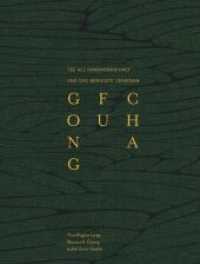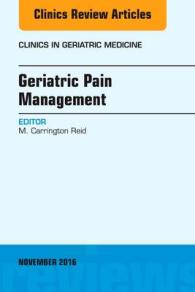- ホーム
- > 洋書
- > 英文書
- > Science / Mathematics
Full Description
Many books have already been written about the perturbation theory of differential equations with a small parameter. Therefore, we would like to give some reasons why the reader should bother with still another book on this topic. Speaking for the present only about ordinary differential equations and their applications, we notice that methods of solutions are so numerous and diverse that this part of applied mathematics appears as an aggregate of poorly connected methods. The majority of these methods require some previous guessing of a structure of the desired asymptotics. The Poincare method of normal forms and the Bogolyubov-Krylov Mitropolsky averaging methods, well known in the literature, should be mentioned specifically in connection with what will follow. These methods do not assume an immediate search for solutions in some special form, but make use of changes of variables close to the identity transformation which bring the initial system to a certain normal form. Applicability of these methods is restricted by special forms of the initial systems.
Contents
1 Matrix Perturbation Theory.- 1.1 Perturbation Theory for a Linear Operator.- 1.2 Main Formulas.- 1.3 Diagonal Leading Operator.- 1.4 General Case. The Normal Form of the Matrix of the Operator M.- 1.5 Nilpotent Leading Operator. The Reconstruction Problem.- 2 Systems of Ordinary Differential Equations with a Small Parameter.- 2.1 Passage to the Linear Problem. Change of Variables Operator.- 2.2 General Formulation of the Perturbation Theory Problem.- 2.3 Canonical Form of First Order Operator X0.- 2.4 An Algebraic Formulation of the Perturbation Theory Problem.- 2.5 The Normal Form of an Operator with Respect to a Nilpotent X0. The Reconstruction Problem.- 2.6 A Connection with N. N. Bogolyubov's Ideas.- 2.7 The Motion Near the Stationary Manifold.- 2.8 Hamiltonian Systems.- 3 Examples.- 3.1 Example: The Pendulum of Variable Length.- 3.2 Example: A Second Order Linear Equation.- 3.3 Example: P. L. Kapitsa's Problem: A Pendulum Suspended from an Oscillating Point.- 3.4 Example: Van der Pol Oscillator with Small Damping.- 3.5 Example: Duffing Oscillator.- 3.6 Example: Drift of a Charged Particle in an Electromagnetic Field.- 3.7 Example: Nonlinear System: Example of an Extension of an Operator.- 3.8 Example: Nonlinear Oscillator with Small Mass and Damping.- 3.9 Example: A Nonlinear Equation; Boundary-Layer-Type Problem.- 3.10 Example: Resonances. Particular Solutions.- 3.11 Example: The Mathieu Equation.- 3.12 Example: Oscillating Spring.- 3.13 Example: Periodic Solution (Hopf's Theorem).- 3.14 Example: Bifurcation.- 3.15 Example: Problem of a Periodic Solution of an Autonomous System.- 3.16 Example: One Problem on Eigenvalues.- 3.17 Example: A. M. Lyapunov's Problem.- 3.18 Example: Illustration for Section 2.5.- 3.19 Example: Fast Rotation of a Solid Body.-3.20 Example: The Langer Problem ([28]).- 4 Reconstruction.- 4.1 Introduction.- 4.2 New Leading Operators in the First Type Problems.- 4.3 The Second Type Problems. "Algebraic" Method of Reconstruction.- 4.4 "Trajectory" Method of Reconstruction.- 4.5 Matching.- 4.6 Example: Illustration for 4.5.- 4.7 Example: Appearance of a New Singularity.- 4.8 Example: Passing Through a Resonance.- 4.9 Example: WKB-Type Problem.- 4.10 Example: Lighthill's Problem [38].- 4.11 Example: Singularity of Coefficients of an Operator.- 4.12 Example: A Second Order Linear Equation.- 4.13 Example: Van der Pol Oscillator (Relaxation Oscillations).- 5 Equations in Partial Derivatives.- 5.1 Functional Derivatives.- 5.2 Equations with Partial Derivatives Whose Principal Part Is an Ordinary Differential Equation.- 5.3 Partial Derivatives. On Whitham Method.- 5.4 Geometric Optics and the Maslov Method.- 5.5 Problem (Whitham).- 5.6 Problem. Diffraction of Short Waves on a Circle (Semishade).- 5.7 One-Dimensional Shock Wave.- References.








